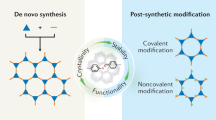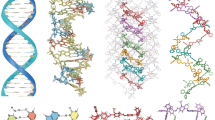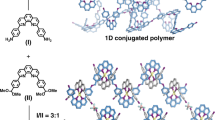Abstract
Single-crystal X-ray diffraction is a powerful characterization technique that enables the determination of atomic arrangements in crystalline materials. Growing or retaining large single crystals amenable to it has, however, remained challenging with covalent organic frameworks (COFs), especially suffering from post-synthetic modifications. Here we show the synthesis of a flexible COF with interpenetrated qtz topology by polymerization of tetra(phenyl)bimesityl-based tetraaldehyde and tetraamine building blocks. The material is shown to be flexible through its large, anisotropic positive thermal expansion along the c axis (αc = +491 × 10–6 K–1), as well as through a structural transformation on the removal of solvent molecules from its pores. The as-synthesized and desolvated materials undergo single-crystal-to-single-crystal transformation by reduction and oxidation of its imine linkages to amine and amide ones, respectively. These redox-induced linkage conversions endow the resulting COFs with improved stability towards strong acid; loading of phosphoric acid leads to anhydrous proton conductivity up to ca. 6.0 × 10−2 S cm−1.

This is a preview of subscription content, access via your institution
Access options
Access Nature and 54 other Nature Portfolio journals
Get Nature+, our best-value online-access subscription
$29.99 / 30 days
cancel any time
Subscribe to this journal
Receive 12 print issues and online access
$259.00 per year
only $21.58 per issue
Buy this article
- Purchase on Springer Link
- Instant access to full article PDF
Prices may be subject to local taxes which are calculated during checkout




Similar content being viewed by others
Data availability
All data supporting the finding of this study are available within this article and its supplementary information. Crystallographic data for the structures in this article have been deposited at the Cambridge Crystallographic Data Centre under deposition nos. CCDC 2162845 (USTB-5), 2162846 (USTB-5r), 2162847 (USTB-5o), 2162848 (recovered USTB-5), 2162849 (USTB-5r obtained in bulky production) and 2234439 (H3PO4@USTB-5o). Copies of the data can be obtained free of charge from https://www.ccdc.cam.ac.uk/structures/. Source data are provided with this paper. In addition, the data that support the findings of this study and the raw data for all the figures have been uploaded to Figshare59 at https://doi.org/10.6084/m9.figshare.20446014.
References
Furukawa, H., Cordova, K. E., O’Keeffe, M. & Yaghi, O. M. The chemistry and applications of metal–organic frameworks. Science 341, 1230444 (2013).
Lin, R.-B. et al. Multifunctional porous hydrogen-bonded organic framework materials. Chem. Soc. Rev. 48, 1362–1389 (2019).
Cui, Y., Yue, Y., Qian, G. & Chen, B. Luminescent functional metal–organic frameworks. Chem. Rev. 112, 1126–1162 (2012).
Zhang, J.-P., Liao, P.-Q., Zhou, H.-L., Lin, R.-B. & Chen, X.-M. Single-crystal X-ray diffraction studies on structural transformations of porous coordination polymers. Chem. Soc. Rev. 43, 5789–5814 (2014).
Jones, J. T. A. et al. Modular and predictable assembly of porous organic molecular crystals. Nature 474, 367–371 (2011).
Howarth, A. J. et al. Chemical, thermal and mechanical stabilities of metal–organic frameworks. Nat. Rev. Mater. 1, 15018 (2016).
Bezzu, C. G., Helliwell, M., Warren, J. E., Allan, D. R. & McKeown, N. B. Heme-like coordination chemistry within nanoporous molecular crystals. Science 327, 1627–1630 (2010).
Yamashina, M. et al. An antiaromatic-walled nanospace. Nature 574, 511–515 (2019).
Diercks, C. S. & Yaghi, O. M. The atom, the molecule, and the covalent organic framework. Science 355, eaal1585 (2017).
Geng, K. et al. Covalent organic frameworks: design, synthesis, and functions. Chem. Rev. 120, 8814–8933 (2020).
Ascherl, L. et al. Molecular docking sites designed for the generation of highly crystalline covalent organic frameworks. Nat. Chem. 8, 310–316 (2016).
Li, X. et al. Partitioning the interlayer space of covalent organic frameworks by embedding pseudorotaxanes in their backbones. Nat. Chem. 12, 1115–1122 (2020).
Liu, K. et al. On-water surface synthesis of crystalline, few-layer two-dimensional polymers assisted by surfactant monolayers. Nat. Chem. 11, 994–1000 (2019).
Jin, Y., Hu, Y. & Zhang, W. Tessellated multiporous two-dimensional covalent organic frameworks. Nat. Rev. Chem. 1, 0056 (2017).
Han, X. et al. Chiral covalent organic frameworks: design, synthesis and property. Chem. Soc. Rev. 49, 6248–6272 (2020).
Koner, K. et al. Porous covalent organic nanotubes and their assembly in loops and toroids. Nat. Chem. 14, 507–514 (2022).
Guan, X. et al. Chemically stable polyarylether-based covalent organic frameworks. Nat. Chem. 11, 587–594 (2019).
Zhao, S. et al. Hydrophilicity gradient in covalent organic frameworks for membrane distillation. Nat. Mater. 20, 1551–1558 (2021).
Dou, H. et al. Microporous framework membranes for precise molecule/ion separations. Chem. Soc. Rev. 50, 986–1029 (2021).
Wang, Z., Zhang, S., Chen, Y., Zhang, Z. & Ma, S. Covalent organic frameworks for separation applications. Chem. Soc. Rev. 49, 708–735 (2020).
Zhang, W. et al. Reconstructed covalent organic frameworks. Nature 604, 72–79 (2022).
Lin, S. et al. Covalent organic frameworks comprising cobalt porphyrins for catalytic CO2 reduction in water. Science 349, 1208–1213 (2015).
Wang, X. et al. Sulfone-containing covalent organic frameworks for photocatalytic hydrogen evolution from water. Nat. Chem. 10, 1180–1189 (2018).
Liu, W. et al. A scalable general synthetic approach toward ultrathin imine-linked two-dimensional covalent organic framework nanosheets for photocatalytic CO2 reduction. J. Am. Chem. Soc. 141, 17431–17440 (2019).
Han, B. et al. Two-dimensional covalent organic frameworks with cobalt(II)-phthalocyanine sites for efficient electrocatalytic carbon dioxide reduction. J. Am. Chem. Soc. 143, 7104–7113 (2021).
Evans, A. M. et al. Thermally conductive ultra-low-k dielectric layers based on two-dimensional covalent organic frameworks. Nat. Mater. 20, 1142–1148 (2021).
Xu, H., Tao, S. & Jiang, D. Proton conduction in crystalline and porous covalent organic frameworks. Nat. Mater. 15, 722–726 (2016).
Chandra, S. et al. Phosphoric acid loaded azo (−N═N−) based covalent organic framework for proton conduction. J. Am. Chem. Soc. 136, 6570–6573 (2014).
Wu, X. et al. Perfluoroalkyl-functionalized covalent organic frameworks with superhydrophobicity for anhydrous proton conduction. J. Am. Chem. Soc. 142, 14357–14364 (2020).
Yang, X. et al. Mesoporous polyimide-linked covalent organic framework with multiple redox-active sites for high-performance cathodic Li storage. Angew. Chem. Int. Ed. 61, e202207043 (2022).
Gao, C., Li, J., Yin, S., Sun, J. & Wang, C. Redox-triggered switching in three-dimensional covalent organic frameworks. Nat. Commun. 11, 4919 (2020).
Liu, C. et al. Transformation of porous organic cages and covalent organic frameworks with efficient iodine vapor capture performance. J. Am. Chem. Soc. 144, 12390–12399 (2022).
Zhang, Y.-B. et al. Single-crystal structure of a covalent organic framework. J. Am. Chem. Soc. 135, 16336–16339 (2013).
Evans, A. M. et al. Seeded growth of single-crystal two-dimensional covalent organic frameworks. Science 361, 52–57 (2018).
Beaudoin, D., Maris, T. & Wuest, J. D. Constructing monocrystalline covalent organic networks by polymerization. Nat. Chem. 5, 830–834 (2013).
Ma, T. et al. Single-crystal x-ray diffraction structures of covalent organic frameworks. Science 361, 48–52 (2018).
Gropp, C., Ma, T., Hanikel, N. & Yaghi, O. M. Design of higher valency in covalent organic frameworks. Science 370, eabd6406 (2020).
Kissel, P., Murray, D. J., Wulftange, W. J., Catalano, V. J. & King, B. T. A nanoporous two-dimensional polymer by single-crystal-to-single-crystal photopolymerization. Nat. Chem. 6, 774–778 (2014).
Schlüter, A. D., Weber, T. & Hofer, G. How to use X-ray diffraction to elucidate 2D polymerization propagation in single crystals. Chem. Soc. Rev. 49, 5140–5158 (2020).
Hu, Y. et al. Single crystals of mechanically entwined helical covalent polymers. Nat. Chem. 13, 660–665 (2021).
Liu, Y. et al. Weaving of organic threads into a crystalline covalent organic framework. Science 351, 365–369 (2016).
Bonneau, C. & O'Keeffe, M. High-symmetry embeddings of interpenetrating periodic nets. Essential rings and patterns of catenation. Acta Crystallogr. A 71, 82–91 (2015).
Li, M., Li, D., O’Keeffe, M. & Yaghi, O. M. Topological analysis of metal–organic frameworks with polytopic linkers and/or multiple building units and the minimal transitivity principle. Chem. Rev. 114, 1343–1370 (2014).
Goodwin, A. L. et al. Colossal positive and negative thermal expansion in the framework material Ag3[Co(CN)6]. Science 319, 794–797 (2008).
Liu, H. et al. Covalent organic frameworks linked by amine bonding for concerted electrochemical reduction of CO2. Chem 4, 1696–1709 (2018).
Waller, P. J. et al. Chemical conversion of linkages in covalent organic frameworks. J. Am. Chem. Soc. 138, 15519–15522 (2016).
Zhu, A.-X. et al. Tuning the gate-opening pressure in a switching pcu coordination network, X-pcu-5-Zn, by pillar-ligand substitution. Angew. Chem. Int. Ed. 58, 18212–18217 (2019).
Yang, Q.-Y. et al. Reversible switching between highly porous and nonporous phases of an interpenetrated diamondoid coordination network that exhibits gate‐opening at methane storage pressures. Angew. Chem. Int. Ed. 57, 5684–5689 (2018).
Segura, J. L., Royuela, S. & Mar Ramos, M. Post-synthetic modification of covalent organic frameworks. Chem. Soc. Rev. 48, 3903–3945 (2019).
Sasmal, H. S. et al. Superprotonic conductivity in flexible porous covalent organic framework membranes. Angew. Chem. Int. Ed. 57, 10894–10898 (2018).
Sahoo, R., Mondal, S., Pal, S. C., Mukherjee, D. & Das, M. C. Covalent-organic frameworks (COFs) as proton conductors. Adv. Energy Mater. 11, 2102300 (2021).
Kim, S. et al. Achieving superprotonic conduction in metal–organic frameworks through iterative design advances. J. Am. Chem. Soc. 140, 1077–1082 (2018).
Tao, S. et al. Confining H3PO4 network in covalent organic frameworks enables proton super flow. Nat. Commun. 11, 1981 (2020).
Li, J. et al. Ultrafast and stable proton conduction in polybenzimidazole covalent organic frameworks via confinement and activation. Angew. Chem. Int. Ed. 60, 12918–12923 (2021).
Hao, L. et al. Pore geometry and surface engineering of covalent organic frameworks for anhydrous proton conduction. Angew. Chem. Int. Ed. 62, e202217240 (2023).
Ramaswamy, P., Wong, N. E. & Shimizu, G. K. H. MOFs as proton conductors—challenges and opportunities. Chem. Soc. Rev. 43, 5913–5932 (2014).
Lim, D.-W. & Kitagawa, H. Proton transport in metal–organic frameworks. Chem. Rev. 120, 8416–8467 (2020).
Umeyama, D., Horike, S., Inukai, M. & Kitagawa, S. Integration of intrinsic proton conduction and guest-accessible nanospace into a coordination polymer. J. Am. Chem. Soc. 135, 11345–11350 (2013).
Yu, B. et al. Linkage conversions in single-crystalline covalent organic frameworks. figshare https://doi.org/10.6084/m9.figshare.20446014 (2023).
Acknowledgements
J.J. was supported by the Natural Science Foundation of China (nos. 22235001, 22175020 and 21631003), the Fundamental Research Funds for the Central Universities (no. FRF-BD-20-14A) and the University of Science and Technology Beijing. H. Wang was supported by the Natural Science Foundation of China (no. 22131005), Xiaomi Young Scholar Program, and University of the Science and Technology Beijing. R.-B.L. was supported by the Natural Science Foundation of China (nos. 22101307 and 22090061) and Hundred Talents Program of Sun Yat-Sen University. G.X. was supported by the Natural Science Foundation of China (nos. 22171263 and 91961115). S.L. was supported by the Natural Science Foundation of China (no. 22178012). We thank M. O’Keeffe at the Arizona State University for helpful discussion on structure expression. In addition, we also thank the staff from BL17B1 beamline of National Facility for Protein Science in Shanghai (NFPS) at Shanghai Synchrotron Radiation Facility for assistance during data collection.
Author information
Authors and Affiliations
Contributions
B.Y., H. Wang, B.C. and J.J. conceived the subject and designed the experiments. B.Y. synthesized the materials and performed most of the characterization experiments with the help of X.L. and K.W. B.Y., Y.J. and H. Wang collected single-crystal X-ray diffraction data. B.Y., R.-B.L., J.-H.L., H. Wang and Z.Y. solved and analysed the crystal structures. G.X., Z.-H.F. and Q.-W.L. carried out impedance experiments. R.-B.L. and J.-H.L. collected PXRD measurements under in situ N2 loading. S.L. and Z.Z. carried out fuel cell experiments. H. Wu and W.Z. built the structure models for activated COFs. B.Y., R.-B.L., H. Wang, B.C. and J.J. interpreted the results and wrote the paper. All authors discussed the results and commented on the manuscript.
Corresponding authors
Ethics declarations
Competing interests
The authors declare no competing interests.
Peer review
Peer review information
Nature Chemistry thanks Satoshi Horike, Gen Zhang and the other, anonymous, reviewer(s) for their contribution to the peer review of this work.
Additional information
Publisher’s note Springer Nature remains neutral with regard to jurisdictional claims in published maps and institutional affiliations.
Extended data
Extended Data Fig. 1 Optical microscopy and SEM photos of single crystals.
Optical microscopy photos of USTB-5 to show the crystallization kinetics together with the SEM photos of USTB-5a, USTB-5ra, and USTB-5oa. [Note]: It should be noted that, under the optimized reaction conditions, the single crystal size of USTB-5 amounts to ca. 50 μm after only 9 hours reaction, which quickly increases to ca. 200 μm after 24 hours. Five days later, single crystals of USTB-5 with the size up to ca. 450 μm and scalability over 0.4 g could be obtained.
Extended Data Fig. 2 Crystal structure of USTB-5.
(a) Asymmetric unit in the single-crystal structure of USTB-5 (2162845). Thermal ellipsoids are drawn with 50% probability. Carbon atom C1 and nitrogen atom N1 in an imine bond are co-occupancy disordered, and only a carbon hydrogen atom therefore appears around the co-occupancy position. (b) The complicated helical tube structure in USTB-5 is composed of two-strand helices and two single helices with atoms in individual helix shown in pink, green, and blue color, respectively. (c) Crystal structure of USTB-5 with three-fold interpenetration nets with all atoms in individual framework shown in pink, green, and blue color, respectively. (d) A qtz topology for USTB-5 with TFPB and TAPB simplified as the same 4-connected node. [Note]: The intercrossing voids between different interpenetrated nets shown in Extended Data Fig. 2b allow both the guest-induced dynamic transformation and post-synthetic chemical conversion depending on the reagent diffused to the imine sites.
Extended Data Fig. 3 Unit cell parameters of USTB-5.
Temperature-dependent unit cell parameters a, b, c, and V for USTB-5.
Extended Data Fig. 4 Crystal structure of USTB-5r.
(a) Asymmetric unit in the single-crystal structure of USTB-5r (2162846). Thermal ellipsoids are drawn with 50% probability. Carbon atom C1 and nitrogen atom N1 in amine bond are co-occupancy disordered, and two carbon hydrogen atoms and a nitrogen hydrogen atom therefore appear around the co-occupancy position. (b) Crystal structure of USTB-5r containing three-fold interpenetration nets with all atoms in individual framework shown in pink, green, and blue color, respectively. [Note]: The low diffraction resolution and structure disorder of USTB-5r prevent us from distinguishing the amine bond length in this compound and the imine bond length in USTB-5.
Extended Data Fig. 5 Crystal structure of USTB-5o.
(a, b) Asymmetric unit in the single-crystal structure of USTB-5o (2162847), which is divided into two parts for clarity. Thermal ellipsoids are drawn with 50% probability. For Extended Data Fig. 5a, carbon atoms C5 and C5A and nitrogen atoms N2 and N2A in amide bond are co-occupancy disordered, respectively, and hydrogen atom on amide nitrogen atom is obscured by oxygen atom in the present case. (c) Crystal structure of USTB-5o containing three-fold interpenetration nets with all atoms in individual framework shown in pink, green, and blue color, respectively.
Extended Data Fig. 6 Structural model of USTB-5a and corresponding N2 sorption isotherms.
(a) Structural model of USTB-5a containing three-fold interpenetration nets with all atoms in individual framework shown in pink, green, and blue color, respectively. Unit cell parameters are a = b = 32.6300 Å, c = 24.6860 Å, α = β = 90°, γ = 120°, and V = 22762.3 Å3 (Z = 18). (b) Hysteretic N2 sorption isotherms at 77 K with the first and second step corresponding to the flexible structure of USTB-5a and USTB-5, respectively. Inset: the structural difference between USTB-5a and USTB-5 along c axis, as mainly indicated by the different pitches for their double-strand helical secondary building blocks.
Extended Data Fig. 7 Structural model of USTB-5oa and corresponding N2 sorption isotherms.
(a) Structural model of USTB-5oa containing three-fold interpenetration nets with all atoms in individual framework shown in pink, green, and blue color, respectively. Unit cell parameters are a = b = 32.6000 Å, c = 25.3600 Å, α = β = 90°, γ = 120°, and V = 23340.8 (Z = 18). (b) Hysteretic N2 sorption isotherms at 77 K with the first and second step corresponding to the flexible structure of USTB-5oa and USTB-5o, respectively. Inset: the structural difference between USTB-5oa and USTB-5o along c axis, as indicated by the different pitches for their double-strand helical secondary building blocks.
Supplementary information
Supplementary Information
Supplementary Figs. 1–59, Tables 1–14, references and disclaimer.
Supplementary Data 1
Crystallographic data for USTB-5.
Supplementary Data 2
Crystallographic data for USTB-5r.
Supplementary Data 3
Crystallographic data for USTB-5o.
Supplementary Data 4
Crystallographic data for recovered USTB-5.
Supplementary Data 5
Crystallographic data for USTB-5r obtained in bulky production.
Supplementary Data 6
Crystallographic data for H3PO4@USTB-5o.
Supplementary Data 7
Data for Supplementary Figs. 19, 21–23, 24a, 42a,b, 44, 45 and 47–50.
Supplementary Data 8
Data for Supplementary Fig. 43.
Source data
Source Data Fig. 3
Source data for Fig. 3.
Source Data Fig. 4
Source data for Fig. 4.
Source Data Extended Data Fig. 3
Source data for Extended Data Fig. 3.
Rights and permissions
Springer Nature or its licensor (e.g. a society or other partner) holds exclusive rights to this article under a publishing agreement with the author(s) or other rightsholder(s); author self-archiving of the accepted manuscript version of this article is solely governed by the terms of such publishing agreement and applicable law.
About this article
Cite this article
Yu, B., Lin, RB., Xu, G. et al. Linkage conversions in single-crystalline covalent organic frameworks. Nat. Chem. 16, 114–121 (2024). https://doi.org/10.1038/s41557-023-01334-7
Received:
Accepted:
Published:
Issue Date:
DOI: https://doi.org/10.1038/s41557-023-01334-7
This article is cited by
-
Dithiine-linked metalphthalocyanine framework with undulated layers for highly efficient and stable H2O2 electroproduction
Nature Communications (2024)
-
Hydrothermal synthesis of polyimide-linked covalent organic frameworks towards ultrafast and stable cathodic sodium storage
Science China Chemistry (2024)



